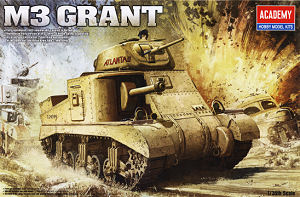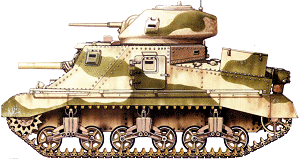| Introduction: |
| The kit: |
The M3 Lee kit had the well documented issue of the oversized suspension bogies as well as some rivet head placement issues yet despite having corrected the suspension in the recent M7 Priest (kit #13210) this kit again includes the incorrect suspension bogies for one of the most amazing Corporate decisions of recent years.
This kit is basically the M3 Lee kit with the turret replaced with the larger Grant turret and still includes some of the Lee turret parts which come in handy to correct some errors with the new Grant parts (the 75mm gun) and as mentioned has the same oversized suspension bogies.
The two sprues A are again the same as from the earlier M3/M4/M10/M12 Academy kits to provide the open spoked road wheels, idlers, return rollers and volute springs plus the final drive housings with everything else on the sprue consigned to the spares box, but don’t be tempted to use the later trailing arm bogies as they were not fitted to the vehicle type included in the kit.
As most of the kit is the same as the Lee kit, much of the review below is also from the M3 Lee review with updated notes on the construction as well as for the new Grant turret and fender parts.
| Lower Hull: |
The lower hull tub includes the upper sponson fillers with nice rivet head details on the underside although these are only partially depicted with the central run of rivets included between the rear and central bogie positions but missing from between the central and front bogie positions. This may be due to the large oval cut-out in this position for the locating lug on the bottom of the inside floor, but the oval lug on the floor doesn’t completely fill the hull opening and so a bit of filler will be needed if you want to bother as this really won’t be seen unless you have the stature of an ant to crawl under the finished model.
There is also additional detail that can be added to the underside of the sponson if you wish with a row of rivets along the outer edge and a drain plug located at the back of each sponson.
The inside floor section includes the escape hatch but there is no corresponding hatch on the bottom hull making this a hatch to nowhere?
The drive sprockets are the fancy smooth type with rounded inner tips on the sprocket disc and have very nice details including extremely fine casting numbers on the inner hub and better defined hub bolt heads than on the sprockets in the earlier Sherman kits.
As mentioned the open spoked road wheels and idlers are from the earlier M4/M10 kits and are nice representations of these wheels and the bogies are early VVSS type without the raised return roller but the units use the same heavy duty springs from the later M4/M10/M36 kits meaning the bogie units are slightly too tall too accommodate these.
The data used here is taken directly from measurements of the fully restored
M3 Grant at the Army
Museum of Western Australia.
The first thing that was apparent was that the six bogie units on the vehicle came up with four different widths of the main bogie housing ranging from 306mm to 310mm wide but this 4mm in real scale means we are talking about 0.1mm in 1:35 and obviously not worth bothering with but does show that things don’t always correspond to drawings or plans exactly.
The width (averaged) was 308mm which equals 8.7mm in 1:35 and the kit bogies are well within acceptable tolerances for this while the depth of the bogie is 13.34mm in 1:35 and the kit bogies again matched this almost perfectly.
The width from mid axle to mid axle is 24mm in 1:35 with the kit parts measuring out at 23.5mm and the width of the road wheel rubber section is 6.2mm in 1:35 with the kit wheels being about 5.8mm and the width of the two drive sprockets 0.6mm narrower than the measurements taken give or take a fraction of a millimetre.
The bogie housing height is just over 2mm too high with the measured height equalling 10.7mm and the kit bogie being 13mm and the return roller as a consequence sits too low and should be higher off the housing if this was the correct height. Also the tops of the bogie units are not rounded as they should be but square which just adds to the problems with these bogies.
Assembly of the bogies is straightforward with the only thing to watch is the orientation of the bogie arms (parts E18, E40) as the locating hole for the pivot pin is a different size in each and the small top ribs (parts E7) have small pin marks on one side but if these are positioned inward are very had to see after assembly.
The front transmission cover includes fine casting numbers on the right side and has separate bolted retaining flanges but remember the “seam” line down the middle of these flanges should be there as the flanges are actually two parts bolted together but the seams on the kit parts are just the moulding seam and you have a bit of a quandary wether to leave or remove as the mould seam is uneven and not actually the engraved seam as it should be and there are also five pin ejector marks between the inside bolts to be dealt with. A separate upper bolted strip is added after the transmission cover is fitted to the hull and the join seam should be filled as this is actually part of the cast transmission cover on the real vehicle.
The final drive covers include the inner drain plugs and small casting numbers on the left cover plus the two towing shackles and final drive covers on the outside hull with the fit of all these parts being very good.
At the back is a separate rear hull panel that fits well to the hull and has separate engine bay doors and four part early cylindrical engine mufflers which were soon replaced with square profile air cleaners and lower fishtail exhausts further indicating the early nature of the kit. There are parts for the idler axle mountings, towing shackles and rear mud guard extensions to finish of the rear end.
The tracks are the wider T51 type in full length vinyl the same as included in the Academy M4/M10/M36 kits but do have a fair bit of flash around the end connectors which will take a bit of work to remove.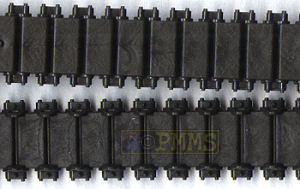
| Upper Hull: |
The many rivets and bolt heads (on engine deck) are well done overall but there are some minor issues with the number of rivets, the positions of others and a few misshapen, if you want to know more about these I will refer you to Rivet Counters Anonymous, otherwise read on.
Overall the hull dimensions are good and match the measurements are taken direct from of the Army Museum of Western Australia Grant hull as well as from the Ordnance Drawings with one small exception.
The depth of the forward engine bay hatch (part B18) is short by about 1.5mm, it should be 21mm in 1:35 scale but is only 19.5mm (give or take a fraction of mm) but the width is correct, there is also a small discrepancy in the size of the mesh opening but this is under 1mm and so not really worth bothering with.
I have previously mentioned the angle of the left side hull panel was off but using newly acquired data (RAAC Ordnance drawings) and remeasuring the vehicle this hull plate angle is okay with the kit part. All other hull dimensions are within a fraction of a millimetre or spot on and therefore well within accepted tolerances so shapes up well overall.
The only locating pin on any of the hull parts are at the rear of the two side panels to ensure these are located correctly to start with and all other plates butt joining to the top and side plates. You have to ensure the side plates are glued evenly along the hull top line as this governs how the rest of the panels will fit.
The right side gun housing has a locating ridge inside the top hull to help position this correctly but the angled left and front panels are a bit tricky due to the lack of locating stubs and some careful aligning before gluing is needed.
The fit of these main hull panels is quite good but depending on how well you line these up before gluing will determine the amount of trimming needed afterwards.
The fit of the rear superstructure wall (part B32) is not good at all unfortunately and a fairly large gap is left between the panel and the hull top to be filled. Also the side rivet heads are elongated and not round due to the limitations of injection moulding.
At the back the large sponson mounted storage boxes are in two parts each and correctly depict the smaller boxes used on Australian and British Grants which don’t go all the way to the edges of the hull but are located inside the rows of hull rivets and are also held in place with small tabs.
The hull side doors are separate and have excellent internal details as well as nicely defined outer hinge detail and separate visor flaps while the top crew hatch is a simple moulding with no internal detail, not that there was much anyway with just three small rivets for each hinge and single latch.
The two side doors are just under 1mm too narrow but again this is not at all noticeable especially if the doors are shown open and not really worth bothering with.
The front plate has a separate driver’s visor that can be positioned open or closed but no inside glass window with wiper is provided that was fitted in place when the port was open and the Driver's periscope fitted to the Grants roof is also missing.
The five fuel filler caps around the forward engine deck are separate parts for good definition as is the aerial mount and ribs on the hull top plus separate pioneer tools with moulded on tool mountings.
For the main gun you get three options, the two from the Lee kit and a new longer M3 75mm barrel with a counter weight included, unfortunately this is incorrect as the longer barrelled guns did not have the counter weight fitted but there is a cut-out on the barrel to take the two part counter weight making this barrel basically unusable.
Thankfully the longer M3 75mm gun is still included from the Lee kit which can be used but the flair at the tip appears slightly too flared but it is the correct length based on the excellent research feature by Kurt Laughlin on Track Link and scaled up 1:48 plans in the Hunnicut Sherman book which show the length of the barrel is 49.1millimeters in 1:35 scale.The other option is of the early M2 75mm gun has the flair at the tip but is without the muzzle counter weights and based on the same data is too long by about 4mm while all barrels are single piece moulds hollowed out to a depth of 3mm using slide moulds for a good appearance and just a very small moulding seam to be cleaned up.
On the inside is a full gun breech with separate breech block, crew seats, traverse wheels and gunner shield with the gun mounting allowing both elevation and traverse. The upper gun sight is also designed in such a way so it will move in unison with the gun traverse.
The fit of the upper and lower hulls was better than on the Lee kit but there were still some minor issues at the rear end as well as with the sponson fillers that may need filling. This may be due to how well you fit all the hull panels together during construction and may vary from kit to kit due to this?| Interior: |
The kit comes with an extensive fighting compartment interior that is easy to see if the large side doors are left open and this starts with the full length floor and rear compartment bulkhead that has nice details included such as the inside vision port detail, the two oil radiators and most of the panel fasteners and rivet detail plus the 37mm ammo racks.
The floor has the lower oval plug as mentioned previously that fits into the hole in the hull bottom leaving a bit of filling if you want to clean up the undersides and there is a multi-part front transmission and gearbox assembly with very nice details for plastic parts with the steering levers and foot pedals as well as the driver’s seat plus raised floor plates and the large central drive shaft cover. On the sponsons are the radio and ammo boxes plus the lower turret ring for a nice interior layout.
Added inside the upper hull front is the driver’s instrument panel with engraved details and the full twin .30 hull machines guns that protrude through the openings in the front hull plate. There are some large pin ejector marks on the insides of the two hull side panels (parts F6, F7) that will need filling if you plan to have the doors open.
Assembly of all these parts was quite straightforward without any traps and very little if any trimming needed with the instructions showing the fit the interior before adding the forward section of the fenders.
The fenders themselves are the extended type with squared off ends for the full side skirt suite fitted to the British Grants in the Western Desert and also include the full side strip used to attach various bits of equipment such as the vehicle tarp cover (not included in the kit) and fitting the interior first will make things easier.
If you choose to add the fender sections first it is still possible to slip the assembled interior and floor section in afterwards without any real problems so choosing the assembly sequence that suits you will work either way.
| Turret: |
The larger Grant 37mm turret has a single moulding for the shell with a separate lower turret ring that has the inside bolted rim included and a separate front gun mounting plate. Just watch the instructions as the gun shield is numbered D53 but should be the new shield part G15, part D53 is not actually in this kit so you might go a little potty trying to find it anyway.
The size of the turret is good overall as the angles match data okay but the curvatures are too square and will need rounding a little using wet and dry for the more rounded appearance of the real Grant turret.
There has been some mention of the turret height but checking this against the Ordnance drawings and the scaled up 1:48 plans in the Hunnicut Sherman book the kit turret matches that data almost perfectly. The height of the left side from the base to the hatch sill in the 1:48 plans is 14.75mm which equates to 20.23mm in 1:35 scale while the kit turret measures 20.5mm in height at this point give or take a fraction for line widths etc. on the scaled up plans. This measurement is taken with the turret fitted to the hull taking into account the small 0.5mm riser including on the hull roof, this riser in fact should be there as clearly shown in photos of Grant tanks.
While you should not take comparing parts between different kits as any guide, a point of interest is the Academy turret is also the same height as the ABM resin turret from set #ABM015.
The two vision ports are separate parts but there is no option to show these open and there is no interior visor detail included.
The Commander’s cupola has the hatch ring with two part hatch but no detail on the inside of the hatches except for some pin marks to be removed.
A full turret basket is included with tread plate pattern on the floor plate and four sections for the basket walls including the open entry hatch and the floor plate has the wall part numbers engraved underneath so you know which part goes where, a nice little touch.
The wall panels include the many 37mm ammo racks with separate 37mm rounds plus the crew seats and traverse motors and again the cramped spaces are portrayed well when all is assembled.
The one piece M6 37mm gun is the early type without the underside counter weight with the barrel the correct length and the muzzle hollowed out using slide moulds for a good appearance, the gun also includes the inner breech and mounting. A separate full .30 cal co-ax MG is included with these fitting through the separate gun mantlet and sighting aperture which in turn fits inside the front gun mounting plate that then fits snugly to the turret opening.
There were no problems assembling these parts but care will be needed lining up the 37mm gun and co-ax .30cal and in attaching the gun supports to the shield if you want the gun to elevate afterwards as there is not a lot of room and its easy to glue where you don’t intend.
There is a fairly prominent join seam between the upper and lower turret parts that will need to be eliminated but the match of the parts is quite good making removing this easier.
| Instructions: |
| Decals: |
The decal sheet has nice thin carrier film cropped close to the printed image and has markings for just two M3 Grants from the British 8th Army in North Africa. That’s the British Army and not the “Royal British Army” as noted in the instructions as the Army was the only arm of the British services not to include “Royal” in the title, individual units did but not the main title.
No actual vehicle identification is given but one is in overall desert tan with the turret name “ATLANTAII” and the other in two tone camouflage.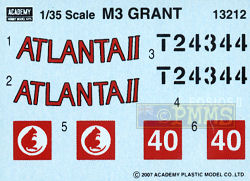
| Conclusion |
This kit is a quite a letdown after the bogies in the Lee kit were corrected in the subsequent M7 Priest kit only to find the same incorrect bogies used again in this kit.
But looking past the bogies the rest of the kit is quite acceptable as it’s basically dimensionally accurate apart from some of the contours on the turret which will need some sanding work to remedy.
There is the extensive interior provided for the lower hull and turret which provides all the basics while allowing scope for additional detailing as with any kit. Assembly is fairly straightforward with just some minor fit issues here and there, and with some basic modelling skills a nice model will result with just the bogies needing replacement.
Thankfully there are already a few aftermarket bogie sets available for the job but really this shouldn’t be needed given the corrected bogies are already in the M7 Priest kit.
This kit is a little hard to score because if it had the correct suspension bogies from the Priest kit it would rate fairly well as a perfectly respectable kit of the Grant could result. But having the old inaccurate suspensions means either a lot of work or further outlay for aftermarket bogies and this drops the rating somewhat.
Recommended 7/10
| The Sprues |








Detail Images




Click Browsers BACK button to return to page
| References: |
| SHERMAN A History of the American Medium Tank R.P.Hunnicutt. Presidio Books ISBN 0-89141-080-5 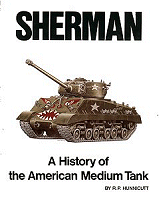 |
M3 Lee/Grant Medium Tank 1941-45 Osprey New Vanguard ISBN 1 84176 889 8 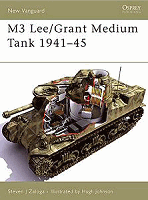 |
Medium Tank M3 to M3A5 General Lee/Grant Tanks in Detail 4 by Terry J Gander. 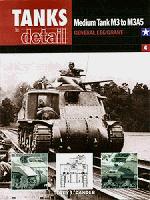 |
| M3 Lee/Grant in action Squadron Signal Publicatrions Armour series #2033 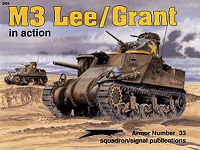 |
Classic AFV's No.2 Lee & Grant An AIRFIX book 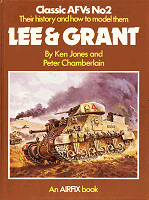 |
Thanks to my credit card and the excellent service from  for
the review kit.
for
the review kit.


